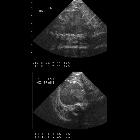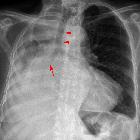Hämatothorax












A hemothorax (plural: hemothoraces), or rarely hematothorax, literally means blood within the chest, is a term usually used to describe a pleural effusion due to accumulation of blood. If a hemothorax occurs concurrently with a pneumothorax it is then termed a hemopneumothorax.
A tension hemothorax refers to hemothorax that results from massive intrathoracic bleeding, causing ipsilateral lung compression and mediastinal displacement .
Pathology
A hemothorax is sometimes defined by pleural fluid with a hematocrit > 50% of the blood hematocrit.
Causes
It usually occurs from penetrating or blunt trauma to the chest (traumatic hemothorax).
A hemothorax can also result without any trauma and, in these situations, it is termed a spontaneous hemothorax. This can occur in the setting of :
- intrathoracic malignancy
- usually occurs with thoracic wall tumors
- thoracic wall schwannomas
- thoracic wall neurofibromas
- soft-tissue tumors
- sarcomas: thoracic angiosarcomas
- hepatocellular carcinomas: with thoracic invasion or thoracic metastases
- lung cancer is a distinctly uncommon cause of hemothorax even in the setting of pleural extension
- usually occurs with thoracic wall tumors
- spontaneous pneumothorax - spontaneous hemopneumothorax
- anticoagulant medication
- vascular rupture
- aortic dissection
rupture of coronary arteries such as RCA during an angioplasty
-
thoracic arteriovenous malformations
- thoracic endometriosis
- pulmonary infarction
- pleural adhesions with pneumothorax
- hematologic abnormalities: coagulopathy
- connective tissue disease
- Ehlers-Danlos syndrome (EDS) type IV: has been associated with hemothorax in the setting of internal mammary artery rupture
- congenital bony exostoses
Radiographic features
Plain radiograph
Chest radiographic appearance of a large hemothorax may be similar to that of pleural effusion. It can be almost impossible to differentiate a hemothorax from other causes of pleural effusions.
Ultrasound
May have a very high sensitivity (92%), specificity (100%) positive predictive values (100%) and negative predictive values (98%) in detection of a hemothorax the context of preceding trauma . Sonographic features characteristic, albeit nonspecific, of hemothoraces include ;
- homogenously echogenic effusion
- typical of hemothoraces in the acute stage
- plankton sign
- hematocrit sign
- implies collection has been present for a longer period of time
- cellular component may layer in the posterior costophrenic recess, creating an interface with the superficial anechoic layer
CT
CT is useful in determining the nature of the pleural fluid in the setting of trauma by assessing the attenuation value. Blood in the pleural space typically has an attenuation of 35-70 HU . Pleural fluid attenuation measurement should be routine in the interpretation of chest trauma CT to distinguish simple fluid from acute blood.
In the setting of trauma, there may be other ancillary features such as pulmonary contusions and lacerations.
Complications
Recognized complications that can after a retained hemothorax include
- infection
- chronic fibrothorax
Treatment and prognosis
Management
The exact management strategy will depend on underlying etiology. In general management options include:
- drainage for symptomatic therapy
For a clotted hemothorax options include:
- video-assisted thoracoscopic surgery (VATS)
- intrapleural fibrinolytic therapy (IPFT)
Siehe auch:
und weiter:

 Assoziationen und Differentialdiagnosen zu Hämatothorax:
Assoziationen und Differentialdiagnosen zu Hämatothorax:




